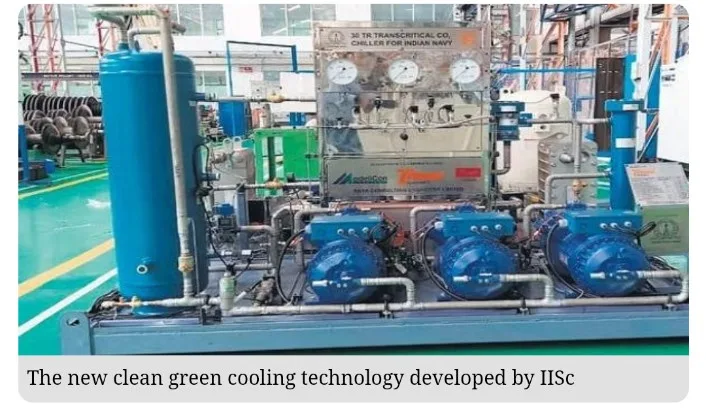Bengaluru, In a groundbreaking achievement, a team of seven scientists and researchers from the Indian Institute of Science (IISc) has unveiled a revolutionary clean and green cooling technology using carbon dioxide (CO2), specifically designed for the Indian Navy. The innovation, a transcritical CO2-based refrigeration and heat pump system, has undergone rigorous testing, completing 1,300 hours at the Maharashtra-based naval base, INS Shivaji. The system is set to be officially inaugurated by the Navy later this month.
Traditionally, refrigeration systems utilize synthetic chemicals like HFCs and HFOs, contributing to significant greenhouse gas emissions. In a strategic move, the Indian Navy sought to adopt an environmentally friendly cooling technology suitable for its ships and submarines. Collaborating with IISc, the Navy envisioned a unique room cooling system utilizing CO2 for its reliability, robustness, stable cooling, and dual functionality for heating.
Unlike synthetic refrigerants developed primarily in Western countries, India currently does not produce its own. These synthetic systems, imported or manufactured under license, pose challenges for safe recycling, often leading to pollution. Natural refrigerants like propane, isobutane, CO2, and ammonia offer environmentally conscious alternatives but require substantial research, training, and investment.
CO2 stands out as a natural refrigerant that is not only non-flammable but also safe and non-toxic. While widely promoted in Western countries for heat pump applications, its adoption in India required re-engineering to suit tropical environmental conditions. The transcritical CO2 system, developed for the first time in India by IISc researchers, has been installed at INS Shivaji and boasts a cooling capacity of 100 kW.
The system, executed in collaboration with industry partners Triveni Turbines, Tata Consulting Engineers (TCE), Danfoss, and Modelicon, has successfully met the Navy’s requirements for compactness, efficiency, and safety. The CO2 system, with a charge of 35kg, has demonstrated stability since its commissioning in September 2022.
Future Scaling and Deployment
Encouraged by the system’s performance, the Indian Navy plans to scale it up to 750 kW or more for deployment on one of its vessels. The advantages observed include a significant reduction in footprint, approximately one-third the size of a synthetic refrigerant-based unit. Additionally, the CO2 system demonstrated faster cooling and better adaptability to changing ambient conditions compared to existing systems.
The success of this green cooling technology not only marks a significant stride in sustainable practices for the Indian Navy but also showcases India’s capability to innovate and implement environmentally friendly solutions in critical sectors.




